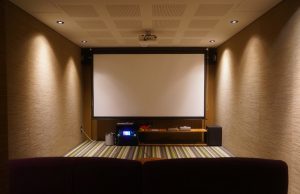There’s something truly magical about dimming the lights, lowering the blinds and letting a cinematic world unfold in your own living space. But getting a perfect home theatre setup is more than simply buying a big TV or projector and a soundbar. It requires thoughtful integration of multiple elements — display, acoustics, seating, wiring, control — to transform a room into an immersive and comfortable viewing sanctuary. Whether you’re starting from scratch or upgrading what you have, a custom home theatre design approach ensures every decision is optimised for your space, preferences and budget.
Below, we explore the essential elements you should get right — and how they interplay to deliver that “wow” factor.
Room & Environment
Room Size, Shape & Layout
The shape of your room (rectangular, square, long and thin) can influence how sound waves behave. Avoid perfectly square rooms if possible, as they can exacerbate unwanted resonances. In deeper rooms, placing your listening position slightly forward from the exact midpoint helps mitigate acoustic problems.
Light Control & Ambient Light
A key difference between a great home theatre and a mediocre one is how well you control stray light. Use blackout curtains, blinds or even heavy drapes to prevent daylight or streetlight from washing out your screen. Matte finishes for walls and avoiding shiny surfaces also help reduce reflections.
Acoustic Treatment
Walls, ceilings and floors reflect, absorb or diffuse sound. Adding acoustic panels, bass traps and diffusers in the right places softens harsh reflections, tames echo, and gives you clearer, more precise sound. Even simple measures — thick carpet, heavy curtains, bookcases — can improve things noticeably.
Display & Screen
Choosing Between Projector or TV
– Projector + screen setups deliver a more cinematic feel, especially for large image sizes, but require darker rooms and good screen surfaces.
– High-end TVs (4K, OLED, QLED) offer superb brightness, contrast and ease of use, especially in ambient light — ideal if your theatre space must double as a living area.
Screen Size, Aspect Ratio & Placement
Your screen’s width should be proportional to the viewing distance. A good rule of thumb: the screen height should sit such that the centre of the image is around eye level (or slightly lower).
Resolution, HDR & Colour Accuracy
To future‑proof your system, aim for 4K HDR or beyond. Look for displays with good colour gamut, contrast ratios, and motion handling. Calibration tools or professional calibration can help you squeeze every drop of fidelity from your display.
Audio & Speaker System
The Foundation — Front, Centre & Surrounds
A successful system hinges on a well‑balanced configuration:
– Front left & right speakers create the stereo base.
– Centre channel handles dialogue clearly.
– Surround speakers wrap you in ambient effects.
Subwoofers & Bass Management
Deep, controlled bass is essential. Use one or more quality subwoofers placed thoughtfully and let your AV receiver manage crossover and level settings.
Amplification & AV Receiver
The AV receiver processes video, routes signals, powers speakers, decodes surround formats, and often includes room correction features. Look for support for Dolby Atmos, DTS:X, and 4K/8K passthrough.
Signal Sources & Connectivity
Media Players, Streamers & Sources
Whether it’s Blu-ray, streaming services or consoles — ensure your system accommodates your preferred content sources.
Wiring & Cable Management
Hidden or neatly routed cabling makes your system both safer and more elegant.
Control & Automation
A seamless home theatre experience is about ease of use. Consider smart control systems that let you dim lights, pull down screens, launch apps or switch inputs in one command.
Seating & Viewing Comfort
Seat Position & Geometry
Your “sweet spot” — where picture and sound converge — ideally touches the centreline of your speaker setup.
Comfort, Layout & Sight Lines
Choose seats that are comfortable for long sessions. Avoid seating that’s too far back, too close, or angled harshly.
System Calibration & Fine Tuning
Speaker Level & Delay Calibration
Properly calibrate speaker distances, levels and crossover settings. Many AV receivers include automatic correction tools.
Video Calibration
Adjust brightness, contrast, colour balance and gamma. A well‑calibrated image can drastically improve viewing pleasure.
Acoustic Tuning
Revisit acoustic treatments and speaker adjustment. Test with real content to listen critically.
Aesthetic & Practical Considerations
Ventilation & Cable Access
Ensure your cabinets or racks have proper airflow. Plan for easy access to cables and future upgrades.
Concealment & Design Integration
Hide or camouflage speakers, wiring, and equipment where possible.
Maintenance & Upgradability
Design your system so it can evolve with new standards and upgrades.
Pulling It All Together
Building a perfect home theatre is a true balancing act — every element affects the next. A beautifully calibrated display is wasted without clear, immersive audio; premium speakers won’t sing if your room acoustics are poor. By approaching the project with a holistic mindset, you allow each part to complement the others, yielding an experience that rivals cinema quality, yet feels comfortably your own.














